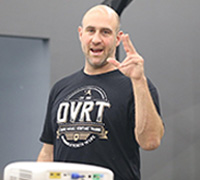Biggest Mistake In Using Kettlebell Swings
This week we have obviously committed to discussing a lot about kettlebell swings. It isn’t just because we launched our new PKM Swing Course, but giving people a better perspective about kettlebell training is something I’ve wanted to do for a long time. I’ve told the story of how I fell in love with kettlebells back in 2002, but sadly over those 20 years, I haven’t seen the training evolve.
Sure, there are countless drills that people create to fix this or that problem in a kettlebell movement, but that ignores the fact a lot our issues (not just in kettlebell training) comes from poor programming and progression. We shouldn’t have to do a million cues and drills to teach people how to optimize movements like kettlebell swings. If we have good programming and build strong progressions, our teaching should become very short and the learning curve as well.
For today, I wanted to cover how I see this as an issue in how people approach kettlebell swings. If I told you I was going to run a marathon every week for a month and then complained that my knee was bothering me, you probably wouldn’t be surprised. However, if someone performs hundreds, if not thousands, of kettlebell swings in a month and my back was not happy and my hip mobility became more problematic, you probably wouldn’t be surprised either.
That does NOT make kettlebell swings bad, it just means we didn’t properly program them and took something good and potentially made it a problem. What I often teach in this regard is that creating a workout program requires that we understand exercise prescription. Just like a drug, exercise can be very effective or it can harm us if we don’t consider the dosage, risks, contraindications, and frequency.

If you are someone that has done such training, please don’t get mad, please hear me out. This has NOTHING to do with kettlebell swings as much as good training overall. There really is no exercise I would approach in this manner. Instead, we should think about what an exercise like kettlebell swings can offer our training program.
For this discussion, we are going to assume you have good technique, so how do we implement the swing effectively? We start by realizing that kettlebell swings fall under our hip hinge pattern. Which means we don’t need 4-6 more exercises that fulfill our hip hinge bucket.

Then we can look at the fact that kettlebell swings are a power based hip hinge. We should ask ourselves if we need to hammer power training in the hip hinge pattern every workout? That can make our training very unbalanced for the movement pattern when we have options to build more of stability and maximal strength in the pattern as you can see below.
This means our weekly programming can include kettlebell swings, but we should be more thoughtful about how we have them interact with the rest of our week. For example a 3 day a week program can look like the following with the hip hinge…
Day 1: Two Handed Kettlebell Swings: Maximal Power Goal
Day 2: Front Loaded Sprinter Stance Good Mornings: Mixture of Strength & Stability
Day 3: Single Leg Single Kettlebell Deadlift: Stability and Strength Emphasis
The next month can be…
Day 1: Sprinter Stance One Arm Swing: Power & Stability
Day 2: Lateral Step Deadlift: Strength & Stability
Day 3: Rear Step MAX Deadlift: Stability & Strength
Reps? Volume should be alternated as well. Meaning, don’t just pick doing 100 reps, instead think of what allows you to keep the highest quality of the movement. In a more stable two handed swing you could program 10-15 reps per set probably easily. If you are performing something like a lateral step swing you may want to consider the complexity of the movement and the fact there are two sides. Therefore, reps from 6-10 a side could be a much better option. You can see though using kettlebell swings, just like any exercise, should be thoughtful and purposeful.
Josh Henkin

Josh is an international presenter and strength coach who has taught in over 13 countries worldwide and consulted with some of the top fitness and performance programs in the world. You can check out his DVRT online fitness educational certifications/courses HERE


